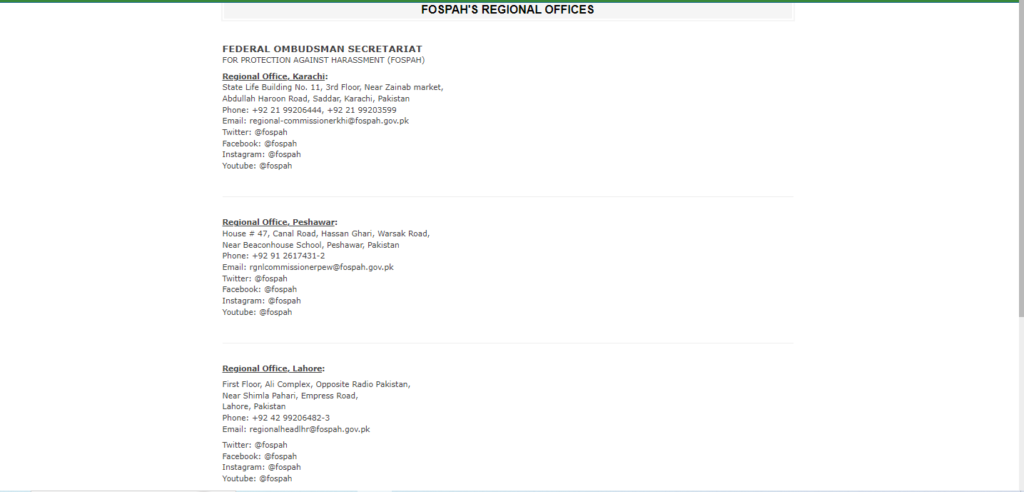Role of the Ombudsman for Women Harassment is crucial in addressing issues of harassment and ensuring a safe environment. This article explores the responsibilities of the Ombudsman, how to file a complaint, and steps individuals can take to seek redress.
Introduction
The Ombudsman for Women Harassment (FOSPAH) plays a critical role in addressing and preventing harassment against women. This guide outlines the responsibilities of the Ombudsman, how to file a complaint, and what to expect during the process.
Role of the Ombudsman (FOSPAH)
Their responsibilities typically include:
- Receiving Complaints: They accept and investigate complaints related to harassment against women, ensuring confidentiality and sensitivity throughout the process.
- Investigating Cases: They conduct impartial investigations into reported incidents of harassment to ascertain the facts and provide recommendations for resolution.
- Providing Redress: They recommend appropriate measures or actions to address the harassment, aiming to ensure justice and prevent recurrence.
- Raising Awareness: They educate the public about laws related to women’s harassment and promote a culture of respect and gender equality.
- Advisory Role: They may advise organizations and institutions on policies and practices to prevent harassment and create safer environments for women.
- Monitoring and Reporting: They monitor trends in harassment cases and may report findings and recommendations to the government or relevant authorities for policy improvement.
Overall, the Ombudsman (FOSPAH) for Women Harassment acts as a vital advocate for women’s rights, striving to eliminate harassment and promote a supportive environment for all individuals.
Types of Harassment Covered
The Ombudsman (FOSPAH) addresses various forms of harassment, including:
- Sexual Harassment: Unwelcome sexual advances, requests for sexual favors, or other verbal or physical conduct of a sexual nature.
- Gender-Based Harassment: Harassment based on a person’s gender identity or expression.
- Workplace Harassment: Harassment occurring in the workplace environment, affecting employment and professional opportunities.
How to File a Complaint
Filing a complaint with the Federal Ombudsman for Women Harassment (FOSPAH) typically involves these steps:
- Gather Information: Collect all relevant details regarding the incident(s) of harassment, including dates, times, and any supporting evidence.
- Prepare Your Complaint: Write a formal complaint detailing the harassment experienced. Include specific incidents, names of individuals involved, and any witnesses.
- Contact the Ombudsman’s Office: Reach out to the Ombudsman for Women Harassment office. You can usually find contact information on official government websites or through local legal aid organizations.
- Submit Your Complaint: Submit your complaint in writing or according to the preferred format of the Ombudsman’s office. Include all relevant documents and evidence that support your complaint.
- Follow Up: Keep track of your complaint’s progress. The Ombudsman’s office may investigate the matter and may require additional information or statements from you.
- Await Response: Wait for a response from the Ombudsman’s office regarding the outcome of their investigation or any actions they plan to take.
- Seek Legal Advice (if necessary): If you encounter any difficulties during the process or require legal guidance, consider seeking advice from a lawyer specializing in harassment cases.
Each jurisdiction may have specific procedures or variations, so it’s essential to check with the relevant Ombudsman’s office or legal authority for precise instructions.
Steps in Filing a Complaint
Here are the general steps involved in filing a complaint:
- Identify the Issue: Clearly understand what your complaint is about and gather any relevant documents or evidence to support your claim.
- Contact the Relevant Party: Reach out to the organization, company, or individual you have a complaint against. This can often be done through customer service, a specific complaints department, or directly to the person involved.
- Prepare Your Complaint: Write down a clear and concise statement outlining your complaint. Include details such as dates, times, names of people involved, and any relevant communication you’ve had.
- Submit Your Complaint: Depending on the organization’s procedure, you may need to submit your complaint through a specific form, email, or letter. Ensure you follow their guidelines for submission.
- Follow Up: After submitting your complaint, monitor the progress. You may need to follow up with the organization to check on the status of your complaint and provide any additional information if requested.
- Resolution: Ideally, the organization will investigate your complaint and provide a resolution. This could involve corrective action, compensation, or other forms of resolution based on the nature of your complaint.
- Escalation: If you are not satisfied with the initial response, there may be further steps within the organization’s complaints process to escalate your complaint to a higher authority.
- External Options: If you exhaust internal options and are still dissatisfied, you may consider external options such as regulatory bodies, ombudsmen, or legal action, depending on the nature of your complaint and the applicable laws.
These steps can vary depending on the context and the organization you are dealing with. It’s important to review the specific procedures outlined by the organization you’re filing a complaint against.
Investigation Process
So here are key steps typically involved:
- Define the Scope: Clearly outline the objectives and boundaries of the investigation to focus efforts effectively.
- Gather Information: Collect pertinent data, evidence, and documentation through various methods such as interviews, document review, site visits, and digital forensics.
- Analyze Evidence: Evaluate the collected information to identify patterns, discrepancies, or correlations that may shed light on the issue being investigated.
- Interview Witnesses: Conduct interviews with relevant individuals to gather firsthand accounts and perspectives on the matter under investigation.
- Maintain Documentation: Keep detailed records of all findings, interviews, and evidence in a structured manner to ensure clarity and traceability.
- Formulate Hypotheses: Develop hypotheses or theories based on the evidence gathered, which will guide further investigation and analysis.
- Draw Conclusions: Synthesize the findings and determine conclusions based on the evidence and analysis conducted.
- Report Findings: Present the investigation findings in a clear, objective, and comprehensive report, including recommendations for any necessary actions or changes.
- Review and Follow-Up: Review the investigation process to identify areas for improvement and ensure that any recommended actions are implemented appropriately.
Each step should be conducted with attention to detail, adherence to legal and ethical standards, and consideration of the overall objectives of the investigation.
Resolution and Recommendations
So here’s a structured approach you can consider:
Resolution
- Summary of Findings: Concisely outline the key findings of the investigation.
- Root Causes Identified: Identify the root causes or contributing factors that led to the issue.
- Impact Assessment: Assess the impact of the issue on stakeholders, operations, or objectives.
- Responsibility Acknowledgment: Clearly state any accountability or responsibility related to the issue.
Recommendations
- Corrective Actions: Propose specific actions to address the identified issues and prevent recurrence.
- Improvement Measures: Suggest improvements to processes, policies, or controls.
- Training and Awareness: Recommend training programs or awareness campaigns to mitigate similar risks in the future.
- Monitoring and Follow-up: Outline plans for monitoring the implementation of recommendations and evaluating their effectiveness.
Legal Recourse
What if harassment is substantiated:
Legal Options
The Ombudsman may recommend legal recourse, including filing a case in civil or criminal court, depending on the severity of the harassment.
Support Services
Throughout the process:
Victim Support
The Ombudsman’s office provides support services to victims, including counseling, legal advice, and referrals to other support organizations.
How to File Complain at Federal Ombudsman Secretariat for Protection Against Harassment (FOSPAH) Online?
So To File complaint you can either file through lawyer or you can also file complaint without lawyer and represent yourself in the case. FOSPAH offers online filing of complaints for the victims as well. you can wither file complaint by physically visiting FOSPAH head office in Islamabad or its regional offices in provincial capitals. to File complaint at FOSPAH online visit following link.
Federal Ombudsman Secretariat for Protection Against Harassment (FOSPAH) Useful links:


FAQs
1. Is filing a complaint with the Ombudsman confidential? Yes, the Ombudsman ensures confidentiality throughout the complaint process to protect the identities of those involved.
2. What happens if the Ombudsman finds evidence of harassment? If harassment is substantiated, the Ombudsman may recommend disciplinary actions, policy changes, or legal recourse.
3. Can the Ombudsman enforce penalties for harassment? The Ombudsman can recommend penalties, but enforcement may require legal action through appropriate authorities.
4. Are there time limits for filing a complaint with the Ombudsman? While it’s advisable to file promptly, the Ombudsman may accept complaints within a reasonable timeframe from the incident.
5. How can workplaces prevent harassment? Workplaces can prevent harassment by implementing clear policies, providing training, and fostering a culture of respect and equality.

